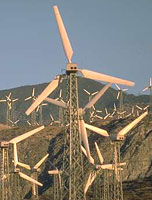
News |
- BC Seismic Testing Threatens Marine Mammals
- Wind Energy Gaining Momentum
- OlyWest Faltering
- Enbridge Seeks New Oil Sands Pipelines Approval
- Office Depot and Xerox: Hot; Not Kimberly-Clark
- First Nations Attempt to Halt Mine Review
- Hydro Licence Appeals to be heard by Cabinet
- Ontario Environmental Priorities: Election Year
- Mackenzie Project: Ottawa Failed to Consult Dene Tha'
- Call for Labeling of GE Foods
- The Water Protection Act - Regulation Review
- BC First Nations Concerned About Mine Decision
| BC Seismic Testing Threatens Marine Mammals | 12 December 06 |
 A proposed research project to conduct seismic testing along the inside passages of Northern and Central BC in September 2007 has the potential to cause deafness or death to marine mammals, fish and invertebrates. This includes salmon, herring, octopus, squid, bears, wolves, sea lions, otters, dolphins and whales. A proposed research project to conduct seismic testing along the inside passages of Northern and Central BC in September 2007 has the potential to cause deafness or death to marine mammals, fish and invertebrates. This includes salmon, herring, octopus, squid, bears, wolves, sea lions, otters, dolphins and whales.The project, called the "Batholiths", would use some of the world's loudest air gun arrays (up to 250 decibels) to determine how the BC Coastal Mountains were formed. The process involves blasting sound every 20 to 60 seconds, for a 3 week period. The sound has been compared to that of a shotgun blast multiplied by 10,000 times or the noise level at a Space Shuttle launch pad, according to Cetacealab, a non-profit whale research station on the north coast of BC. Cetacealab, who is opposed to the project and seeking public support, said the proposed timing of the seismic testing is the worst possible as it coincides with peak abundance of humpback whales. The whales come into inside channels to feed before starting their annual migration to Hawaii. Disruption may prevent them from reaching their calving grounds or returning to these feeding locations. Northern Resident Orcas and Transient Orcas also frequent the area of the proposed seismic tests. humpback whales and orcas are considered threatened species and are protected under Canada's Species at Risk Act. The time of year this project would convene also coincides with the fall run of Sockeye, Coho and Chum Salmon as they go to spawn in the many rivers along the path of this seismic survey. There is evidence that seismic testing can cause serious damage to fish. The Raincoast Conservation Society said the information sought by the Batholiths project can be collected passively by locating instruments on the ocean floor and waiting for natural seismic activity, rather than exposing marine life to the man-made sounds created by seismic air guns. View Cetacealab and the North Coast Cetacean Society information on the Batholiths project View the Raincoast Conservation Society web page for its Marine Mammals Project View the Raincoast Conservation Society backgrounder on the Batholiths project (PDF) View the Canadian Environmental Assessment Agency Registry page on the Batholiths project Sources: Cetacealab, Raincoast Conservation Society
|
|
| Wind Energy Gaining Momentum | 12 December 06 |
 Within Canada and worldwide, wind energy is growing steadily as is the demand for renewable energy that minimizes greenhouse gas emissions. Within Canada and worldwide, wind energy is growing steadily as is the demand for renewable energy that minimizes greenhouse gas emissions.According to a report by the Global Wind Energy Council (GWEC) and Greenpeace International, wind has the potential to supply one third of the world's electricity by 2050. Noting its key role in the fight against dangerous climate change, the report - the Global Wind Energy Outlook 2006, offers a blueprint for wind to supply 16.5% of global electricity by 2020, saving 1.5 billion tonnes of CO2 emissions, and to supply 34% of global electricity by 2050. The report also states that the world's installed wind capacity has grown over 12-fold from just 4,800 MW in 1995 to over 59,000 MW at the end of 2005. Here in Canada, 2006 has already been a record-breaking year for wind power. 767 MW of new wind energy capacity were installed in 2006, representing more than $1 billion in investment, and shattering the previous annual installation record of 240 MW set in 2005. As a result, Canada's total installed wind energy capacity sits at 1,451 MW, a virtual doubling of the 684 MW in place at the start of the year, and enough capacity to meet the electricity needs of 440,000 Canadian homes. Economically, Canada's wind energy industry contributed $736 million to Canada's Gross Domestic Product in 2005 according to the Canadian Wind Energy Association (CanWEA). It is also estimated that there were 1,200 full-time equivalent jobs (FTE) in the wind energy industry in 2005, an increase of 65% over 2004. Canadian wind energy industry revenues in 2005 are estimated at $548 million, a 100% increase over 2004 levels. Industry members project that wind energy industry revenues will again show a doubling for 2006. View the September 20, 2006 Forbes article View the Greenpeace report Global Wind Energy Outlook 2006 View Canadian Wind Energy Association (CanWEA) press releases: November 22, 2006 - October 24, 2006 - October 23, 2006 Sources: Forbes, Greenpeace, CanWEA
|
|
| OlyWest Faltering | 07 December 06 |
 Two of three partners involved in the proposed OlyWest hog processing plant in Winnipeg announced they are pulling out of the project. Two of three partners involved in the proposed OlyWest hog processing plant in Winnipeg announced they are pulling out of the project.Olymel of Quebec indicated financial troubles were a significant factor in its decision, but it and Big Sky Farms of Humboldt, Sask. also cited the Manitoba government moratorium on new and expanding hog operations imposed November, 2006 Manitoba as a factor. OlyWest has repeatedly stated that existing hog barns would supply the proposed slaughter plant. Premier Doer said Olymel's financial troubles and cutbacks across the Canadian hog industry are the real reason Olymel and Big Sky Farms abandoned OlyWest. Big Sky president and CEO Florian Possberg admitted the province will need more finishing barns to bring animals to market weight. Although the remaining partner, Hytek, said it will proceed with the project on its own, financial incentive packages from the City of Winnipeg and the Province will now have to be revisited. Hytek must resubmit a proposal to the city because the existing agreement refers to a three-party consortium, said city economic development manager Jim Paterson. Meanwhile, Premier Gary Doer said the province must look at whether Hytek still qualifies for a $20-million provincial loan promised to the OlyWest consortium at preferential rates. Questions surrounding the Environment Act review and intended Clean Environment Commission hearings also exist. It is not clear whether Hytek will be required to resubmit the environmental licence application now the licence applicants are no longer the same. David Hedman, chair of the Oly Opp Alliance, successfully obtained the results of city of Winnipeg polling which show that more than half of respondents opposed the plant. Freedom of information requests were blocked and took months to solve. "What we need is a plebiscite. Winnipeggers would clearly tell their governments this plant should go away." View the December 7, 2006 letter and Poll results from Ombudsman Manitoba to David Hedman (PDF) View the December 6, 2006 Winnipeg Free Press articles: 1, 2, 3 (DOCs) View the December 5, 2006 CBC articles: 1, 2 View past Manitoba Wildlands news items about OlyWest: November 21, 2006 - OlyWest Investigation, Hearing Delay? November 17, 2006 - Hog Barns Moratorium, Water Protection Review October 13, 2006 - OlyOpp Alliance Launch to Oppose OlyWest September 14, 2006 - CEC Hearings for OlyWest Hog Plant July 20, 2006 - Confusion Over OlyWest Hearings May 1, 2006 - Opposition to Winnipeg Hog Plant Gains Momentum Sources: Winnipeg Free Press, CBC
|
|
| Enbridge Seeks New Oil Sands Pipelines Approval | 05 December 06 |
 Enbridge has announced its intention to construct two new crude oil pipelines as a result of expansions of production in Alberta's growing oil sands. Enbridge has announced its intention to construct two new crude oil pipelines as a result of expansions of production in Alberta's growing oil sands.Alberta Clipper will run 1,590 km between Hardisty, Alberta and Superior, Wisconsin primarily using existing Enbridge right-of-way; approximately 65 km of new right-of-way is needed pipeline near Regina, Milden and Kipling, Saskatchewan, and Morden, Manitoba. The pipeline would have an initial capacity of 450,000 barrels per day, with potential to expand to 800,000 barrels per day. The Southern Lights pipeline would transport 180,000 barrels per day of diluent, a hydrocarbon fluid used to dilute and reduce viscosity of heavy crude for easy transport, from the US to Alberta. The project would involve reversing the flow of Enbridge's existing Line 13 and would require new pipeline between Cromer, Manitoba and Clearbrook, Wisconsin. Both projects will be subject to review by the National Energy Board; Enbridge will be filing applications in 2007. Enbridge has started to provide information to the public in Saskatchewan and Manitoba about the projects through a series of open houses. The first took place on November 27, 2006 - see below to download the complete schedule. View Enbridge web pages on: Alberta Clipper & Southern Lights View the November 20, 2006 Enbridge letter, public open houses, & proposed pipeline map (PDF) View the National Energy Board Pipeline brochure (PDF) Source: Enbridge
|
|
| Office Depot and Xerox: Hot; Not Kimberly-Clark | 05 December 06 |
 While Office Depot is releasing a "Green Book" catalog of environmentally preferable products it carries and Xerox is investing $1 million in an innovative partnership with The Nature Conservancy, tissue manufacturing giant Kimberly-Clark continues to be under fire for failing to keep its promises to protect ancient boreal forests in Canada. While Office Depot is releasing a "Green Book" catalog of environmentally preferable products it carries and Xerox is investing $1 million in an innovative partnership with The Nature Conservancy, tissue manufacturing giant Kimberly-Clark continues to be under fire for failing to keep its promises to protect ancient boreal forests in Canada.This year's Green Book catalog contains more than 6,000 different products including remanufactured ink and toner cartridges, recycled paper products and Energy Star qualified equipment. A large number of products listed received independent, third party certification through the Forest Stewardship Council (FSC), Green Seal, Blue Angel or Nordic Swan. Xerox's investment with The Nature Conservancy will strengthen practices used to conserve the world's forests. In Canada, the partnership will help catalyze a science-based data center providing information on ecologically important boreal areas, which stretch from Newfoundland west across Canada. An online interactive database will be available to Xerox's paper suppliers as they conduct planning and logging operations. Greenpeace activists recently confronted Kimberly-Clark at its regional headquarters in Turin, Italy demanding the company "Stop Flushing Canada's Boreal forest Down Europe's toilets" by placing toilet bowls outside the office with trees being 'flushed down'. Almost one-third of the virgin pulp used to make Kimberly-Clark European products and one-fifth of its global pulp is from destructive logging operations in Canadian forests, including the Boreal forest. View the September 27, 2006 Forbes article View the November 9, 2006 Greenpeace press release View the October 20, 2006 GreenBiz News article View the October 26, 2006 Nature Conservancy press release Sources: Forbes, Greenpeace, GreenBiz News, Nature Conservancy
|
|
| First Nations Attempt to Halt Mine Review | 05 December 06 |
 Representatives of Tse Keh Nay Nation and Gitxsan House of Nii Kyap were in Victoria November 29th to ask a joint federal-provincial environmental panel to shut down its review of Northgate Minerals' $200-million mine project in northern B.C. until First Nations are properly consulted and provided with funding to engage in the consultations. The panel added the extra day of public hearings in Victoria to hear the Gitxsan motion introduced during the hearings in Smithers the previous week. Representatives of Tse Keh Nay Nation and Gitxsan House of Nii Kyap were in Victoria November 29th to ask a joint federal-provincial environmental panel to shut down its review of Northgate Minerals' $200-million mine project in northern B.C. until First Nations are properly consulted and provided with funding to engage in the consultations. The panel added the extra day of public hearings in Victoria to hear the Gitxsan motion introduced during the hearings in Smithers the previous week. One key environmental issue is use of Duncan Lake to store mine waste. The Tse Keh Nay Nations are vehemently opposed to the use of Duncan Lake, called Amazay in the Sekani language. The First Nations are concerned about Duncan Lake, which is home to several species of fish, and potential acid runoff into the Finlay River system. Northgate says the lake is the best environmental option and the only economically feasible option: $200 million versus the next scenario at $1 billion. Provincial mining officials agreed it's the best environmental option. Richard Sampson, communication officer for the Gitxsan Chiefs, said from the onset the Gitxsan have wanted to be involved in the process as long as it was balanced and fair. He feels Northgate is banking on the fact that the band does not have the same funding so they can bulldoze the project through. View the November 30, 2006 Interior News article View the November 29, 2006 Prince George Citizen article View the December 1, 2006 Tse Keh Nay press release (DOC) View the November 22, 2006 MiningWatch Canada press release View the Canadian Environmental Assessment Agency web page for the Kemess North Gold-Copper Mine Visit the Tse Keh Nay Online website View Manitoba Wildlands' previous news items: November 23, 2006 & October 31, 2006 Sources: Prince George Citizen, Interior News
|
|
| Hydro Licence Appeals to be heard by Cabinet | 29 November 06 |
 The Manitoba Government is taking new steps in its handling of appeals of the Wuskwatim Generating Station environmental licence. The licence appeals under Manitoba's Environment Act will be heard by Cabinet. The Manitoba Government is taking new steps in its handling of appeals of the Wuskwatim Generating Station environmental licence. The licence appeals under Manitoba's Environment Act will be heard by Cabinet.Two appeals of the Generating Station licence were filed August 2, 2006, from Manitoba Wildlands, represented by director Gaile Whelan Enns, and from Trapline 18, represented by Greg McIvor. The appeals are based on issues consistently raised during The Environment Act review of the Wuskwatim projects and during the 2004 Clean Environment Commission (CEC) public hearings for the projects. "The news Cabinet would be hearing these appeals was a surprise and we feel it is important the public know that these appeals are unfolding," said Manitoba Wildlands Director Gaile Whelan Enns. "We have, however, had concerns about procedural and administrative fairness throughout this process. We also think Manitoba Hydro should disclose information requested since 2003." Greg McIvor, who speaks for Trapline 18, explained the basis of their appeal: "We spent time and money for four years to have the damage from existing hydro development and potential damage from the Wuskwatim project to our trapline acknowledged. Our Appeal submission asks for accountability of the Governments for hydro development, fairness, honesty and respect for Trap Line 18. It also asks Cabinet to order disclosure of relevant up-to-date facts, not disclosed at the CEC hearings, which are in the possession and control of Manitoba Hydro. Then the Government must order a 'public CEC hearing' to correct the wrongs of the first process." David Newman is legal counsel for Trapline 18 and a former minister in Manitoba's cabinet responsible for Manitoba Hydro. View the Manitoba Wildlands November 27, 2006 appeal submission re the Wuskwatim Generating Station licence (PDF) View the Trapline 18 November 24, 2006 appeal submission for the Wuskwatim Generating Station (PDF) View the Manitoba Wildlands August 2, 2006 appeal letter re the Wuskwatim Generation Station licence (PDF) View the Trapline 18 August 2, 2006 appeal letter re the Wuskwatim Generating Station Licence (DOC) Sources: Manitoba Wildlands, Trapline 18
|
|
| Ontario Environmental Priorities: Election Year | 28 November 06 |
 Thirteen Ontario environmental groups have banded together to put their issues onto the public agenda for the October election in 2007. Thirteen Ontario environmental groups have banded together to put their issues onto the public agenda for the October election in 2007.The group of 13 outlined six priority areas for political parties to address:
"It's remarkable - indeed unprecedented - to have so many groups come to consensus around a focused agenda like this," said Bruce Cox of Greenpeace. "This degree of unanimity sends the clearest possible message to our political leaders as to what needs to be done to create a green future for our province." View the November 9, 2006 'Group of 13' press release View the November 11, 2006 Toronto Star article Sources: Toronto Star, PrioritiesForOntario.ca
|
|
| Mackenzie Project: Ottawa Failed to Consult Dene Tha' | 28 November 06 |
 The future of hearings into the $7-billion Mackenzie natural gas pipeline has been thrown into doubt after a Federal Court judge ruled November 10, 2006 that Ottawa failed to consult with the Dene Tha'. The future of hearings into the $7-billion Mackenzie natural gas pipeline has been thrown into doubt after a Federal Court judge ruled November 10, 2006 that Ottawa failed to consult with the Dene Tha'.Justice Michael Phelan ordered hearings on any aspect of the project affecting Dene Tha' lands in northern Alberta to cease until the Dene Tha's concerns are met, said their lawyer, Robert Freedman. The Dene Tha' number about 2,500 on seven reserves in northwestern Alberta, northeastern British Columbia and Northwest Territories. They were excluded from a regulatory process since 2002 involving federal energy and environment officials and aboriginal groups because the final leg of the pipeline and infrastructure connecting it to existing networks would be in northern Alberta. The Dene Tha' have long argued separating the connecting facility from the main pipeline in the review robs them of any input. In his ruling, Phelan wrote development on Dene Tha' lands was just as much part of the pipeline as any other work. Justice Phelan ordered a remedial hearing on:
View the November 10, 2006 Canadian Press article on CNEWS View the November 10, 2006 Federal Court of Canada Judgment (PDF) Visit the Joint Review Panel for the Mackenzie Gas Project website Visit the Dene Tha' website Source: Canadian Press
|
|
| Call for Labeling of GE Foods | 28 November 06 |
 Greenpeace urged British Columbia's Agriculture Planning Committee to require all genetically engineered (GE) food be labeled during public hearings fall 2006. The demand echoes recommendations of the provincial health officer, Dr. Perry Kendall, who in his 2005 annual report, concluded that all GE foods should be labeled. Greenpeace urged British Columbia's Agriculture Planning Committee to require all genetically engineered (GE) food be labeled during public hearings fall 2006. The demand echoes recommendations of the provincial health officer, Dr. Perry Kendall, who in his 2005 annual report, concluded that all GE foods should be labeled.Canada's previous Liberal government refused to require mandatory labeling, and instead adopted a voluntary system in 2004. Since then, not one label has been found in Canada's supermarkets indicating food contained or was made from GE crops. Corn, canola and soy are the main GE crops found in about 70% of processed food sold in Canada; it is likely many foods currently on the shelves are genetically engineered. Greenpeace argues the lack of labels illustrates the ineffectiveness of voluntary compliance and the need for mandatory labeling. Other provinces are beginning to take action on the issue. Quebec is moving toward provincial mandatory labeling. The Prince Edward Island Standing Committee on Agriculture recommended labeling of foods that are and are not products of genetic modification, stressing that such labels should be informative, understandable and verifiable. View the October 20, 2006 Greenpeace Canada press release Source: Greenpeace Canada
|
|
| The Water Protection Act - Regulation Review | 23 November 06 |
 The Manitoba government has released a draft Nutrient Management Regulation under The Water Protection Act. The stated purpose of the proposed regulation is to "protect water quality by encouraging responsible nutrient planning, regulating the application of materials containing nutrients and restricting the development of certain types of facilities in environmentally sensitive areas". The Manitoba government has released a draft Nutrient Management Regulation under The Water Protection Act. The stated purpose of the proposed regulation is to "protect water quality by encouraging responsible nutrient planning, regulating the application of materials containing nutrients and restricting the development of certain types of facilities in environmentally sensitive areas".The draft regulation follows public meetings organized by Manitoba Water Stewardship and Manitoba Conservation during February and March 2006 which resulted in a November 2006 report. This process was also preceded by a Manitoba Water Stewardship's July 20, 2005 consultation document, Regulation Under the Manitoba Water Protection Act - Consultation Document for Initial Review Respecting Water Quality Management Zones for Nutrients and the February 2006 document, Issues and Options Arising from Initial Consultations on Water Quality Management Zones for Nutrients. In accordance with The Water Protection Act, the proposed regulation is being made available for review and comment. Comments and objections respecting the proposed regulation are being accepted for a 60-day period; submissions must be made in writing by January 22, 2007. View the Manitoba Water Stewardship webpage on the Draft Nutrient Management Regulation View the November 2006 report, Report on Consultations - Proposed Regulation Defining Water Quality Management Zones for Nutrients and Proposed Amendments to the Livestock Manure and Mortalities Management Regulation (PDF) View the Draft Nutrient Management Regulation under The Water Protection Act (PDF) View Manitoba Wildlands' for history on the draft Nutrient Management Regulation Sources: Manitoba Water Stewardship, Manitoba Wildlands
|
|
| BC First Nations Concerned About Mine Decision | 23 November 06 |
 The Tse Keh Nay (Takla, Tsay Keh Dene, and Kwadacha First Nations) in British Columbia are calling for more substantive involvement of First Nations in decisions about mining developments. The Tse Keh Nay (Takla, Tsay Keh Dene, and Kwadacha First Nations) in British Columbia are calling for more substantive involvement of First Nations in decisions about mining developments.Chief John French of Takla stated "the Environmental Assessment process is still a long way from meaningful involvement of First Nations in decision-making". The Chiefs are frustrated and allege that governments are not following their legal obligations to consult and accommodate First Nations. The Chiefs are also asking whether there can be any real assessment of alternatives when Northgate Minerals insists there only is one option: destroying Amazay (Duncan Lake). The proposed Kemess North copper-gold mine would be built 400 km northwest of Prince George, British Columbia, Canada, and turn Duncan Lake into a tailings pond. "The Tse Keh Nay people are extremely concerned about impacts on the watershed," stated Grand Chief Pierre. "Our people don't believe it is possible to keep all that poison contained in a dam at the top of the watershed. The company will make their millions and leave and we'll be left wondering when the dam will fail and poison the rest of our water." "The Premier made commitments to a New Relationship and shared decision-making with First Nations. It's time to see those good commitments on major projects like this where the potential impacts on our aboriginal rights and our Territory are extremely high." said Chief French. View the October 30, 2006 Takla, Tsay Keh Dene, & Kwadacha First Nations press release View the November 8, 2006 Prince George Free Press article View the Manitoba Wildlands' October 31, 2006 news item Visit the Tse Keh Nay Online website Sources: MiningWatch Canada, Prince George Free Press
|
|


 RSS Feeds:
RSS Feeds: